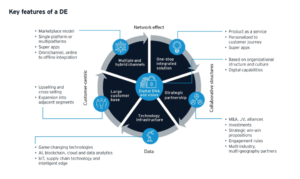
A superapp to a ‘travel superapp’: How AirAsia is upping the anteSource: Shutterstock
Digital ecosystems foster collaboration and partnership
Digital ecosystems provide opportunities for traditional market players to leverage partnerships and strategic alliances. This results in the sharing of resources, data, and capabilities to compete with digital natives, through the avenues of collaboration, partnerships, and mergers and acquisitions (M&As), according to a recent report by Ernst & Young (EY).
Traditional firms lagging behind digital natives
While established, traditional firms – given their large user base, reach and capital assets – are well-placed to orchestrate a digital ecosystem, they are often outpaced by the emerging digital natives that are ahead in digital adoption.
“Most traditional firms have been focusing on their core business and may be hesitant to build a platform-based business due to legacy systems and corporate culture.
Thus, traditional firms are turning to collaborate with e-commerce and last-mile platforms to offer digitalized, streamlined, and omnichannel experiences to their customers,” said EY-Parthenon Asean Leader Joongshik Wang.
Digital ecosystems powered by “super apps”
In the report, titled “Building successful digital ecosystems in Southeast Asia”, EY revealed that, between 2016 and 2020, the region saw technology transactions worth US$408.5 billion, with most investments going to the areas of mobile applications, cloud computing, artificial intelligence, big data and analytics, blockchain, and IoT.
The report also revealed that collaborative consumption and the sharing economy have been on the rise, driven by a regional average of 63% for internet penetration, as well as a growing tech-savvy middle-class population that is rapidly moving up the socio-economic ladder. This facilitates sharing models across different sectors such as mobility, travel and hospitality, and real estate.
Digital ecosystems – defined by EY as interconnected sets of offerings that fulfill consumer needs in one integrated experience that comprises businesses across different sectors to collectively offer a broad range of products and services – are forming across Southeast Asia, in response to digital disruptions of industries, which is further accelerated by the Covid-19 pandemic.

Key features of a digital ecosystem. Source: EY
The platforms that provide this integrated experience have become known as super apps, which have attracted investor attention to the tune of US$43 billion between 2016 to 2019. The growing digital ecosystems in Southeast Asia have the potential to generate revenue opportunities of US$23 billion by 2025, from US$4 billion in 2019.
Just yesterday, AirAsia launched AirAsia Ride in Malaysia, a ride-hailing service as part of its other offerings on its super app, and putting it head to head with industry stalwart Grab.
“There is a rapid growth of startups and digital natives. Some of the leading digital natives in Southeast Asia are transforming into super digital platforms, by delivering interconnected services through an integrated experience – from ride-hailing, food delivery, grocery, logistics, through health, lifestyle and financial services,” said EY Asean Regional Managing Partner Liew Nam Soon.
He noted that consumers today expect speed, responsiveness, and access, coupled with a hyper-personalized experience. Digital ecosystems help companies to create value through revenue growth, gain new market access while decreasing customer acquisition costs, and strengthen and retain customer relationships, he added.
Considerations for businesses
The report also highlighted three areas that organizations should consider when navigating digital ecosystems, the first of which requires the organization to evaluate its digital ecosystem maturity.
The three levels of digital maturity are adaptor, where transformation is at a modular level and limited to a particular business unit or geographic market; accelerator, where the organization scales the transformation to a company and industry level; and attacker, where the organization drives large-scale transformation across multiple industries through cross-sector collaborations and leverage technology across different parts of the value chain.
The organization then defines its business model as a participant in the digital ecosystem, based on parameters such as the nature of the ecosystem, the scale of industry partnerships, and the revenue model.
This is followed by implementation, through identifying a digital ecosystem opportunity, then following a process to design an ecosystem. This includes identifying the most suitable role for the organization, the nature of the ecosystem, product-market fit and monetization model, and the key enablers, before defining the evolution roadmap.
“Digital interactions in both B2B and B2C activities are expected to stay and gain ground even after the pandemic, and enterprises in Southeast Asia will be seeking to transform their business digitally to drive profitable growth as well as work with partners to provide solutions leveraging technology to address value gaps. A partnership model can provide significant momentum for their digital transformation journeys.”
“Importantly, companies must be clear of their strategic objectives, whether it is to achieve core business growth, enter a new market segment through new or digital offerings, to optimize operations, or a combination. This will help them chart their roles in a digital ecosystem effectively,” concluded Liew.
READ MORE
- Strategies for Democratizing GenAI
- The criticality of endpoint management in cybersecurity and operations
- Ethical AI: The renewed importance of safeguarding data and customer privacy in Generative AI applications
- How Japan balances AI-driven opportunities with cybersecurity needs
- Deploying SASE: Benchmarking your approach


